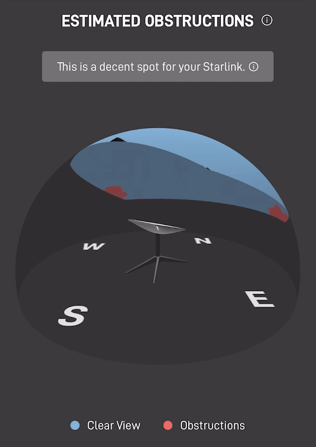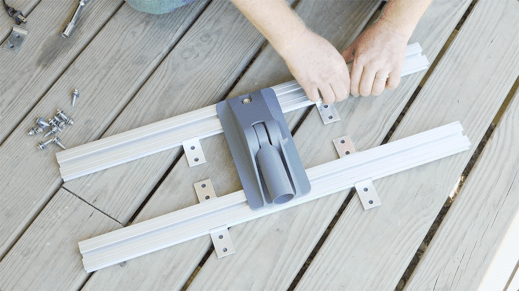The Starlink satellite dish provides high-speed internet connection for rural areas, making it extremely popular among both residential and commercial customers. Installing Starlink is an easy do-it-yourself job, but the kits provided do not include mounting hardware. You’ll need to purchase hardware separately that will not harm your metal roof or jeopardize its weather integrity.
Today, we’ll cover why a metal roof is the perfect platform for installing Starlink. We’ll also provide important details on how to preserve your metal roof’s long service life and warranty, in addition to the mounting options best suited for your specific metal roof profile.
Where Should You Mount a Starlink Dish?
(Video: Demonstration of how the Starlink app helps you locate the best mounting spot for your satellite dish to ensure maximum sky exposure).
Starlink is often your best option for establishing stable internet connectivity. But unlike traditional internet service, Starlink terminals are not connected via cable. Instead, the dish collects radio signals bounced into space and relayed back to earth via satellite. This means your dish must have a clear view of the sky to provide uninterrupted service.

Any obstruction – from trees, poles, buildings or awnings – can interfere with the internet signal. Locating the dish high on your metal roof can help you rise above some of the barriers that might disrupt the signal. Starlink provides a downloadable mobile app that scans for obstructions in the surrounding area. The app pinpoints the clearest patch of sky for receiving the satellite signal, and it will help you determine the best spot on your rooftop to install the dish.
(Image to the left: Starlink mobile phone app illustrating how to position the satellite dish for maximum sky exposure).
What Mounts Work With Starlink?
As you consider Starlink dish mounting options, it’s important to purchase those made specifically for metal roofing by a reputable manufacturer. Don’t take any chances with mounts that may cause harm through unnecessary penetrations, corrosion or water intrusion.
DID YOU KNOW?
Typical ballast used to hold down rooftop ancillaries may include wood or concrete blocks. But both of these can permanently damage metal roofing.
(Image: Cinder blocks used to support and secure a satellite dish on a metal roof).
Some mounting options suggest using ballast for weight to hold down the assembly, but this is a poor choice for metal roofing. Typical ballast includes wood or concrete blocks, and both can permanently damage metal roofing. Wood traps moisture leading to corrosion, and the chemicals used in treated lumber can degrade the metal panels. Concrete blocks also trap and hold moisture, and can create places of pooling water and rust. In addition, the alkalis in concrete attack the roof’s protective coatings.
(Image: Two satellite dishes mounted on a metal roof with cinder blocks to hold them down).
(Image: Ballast placed on top of a satellite dish to secure it to the metal roof).
Purchase
attachments
with the inherent strength to secure your satellite dish without ballast – even in harsh weather. This will protect the investment in your metal roof and Starlink components, as well as help maintain consistent internet connectivity.
 Ease of installation is another important factor to consider.
A Starlink dish takes only minutes to mount to the roof if the correct hardware is used.
Ease of installation is another important factor to consider.
A Starlink dish takes only minutes to mount to the roof if the correct hardware is used.
Some
attachments
easily
interface with the variety of bases Starlink provides and perform double duty, allowing you to manage the wires and keep them off the metal roof.
Exposed-Fastened Trapezoidal or Corrugated Roofing
Install Starlink with a secure mounting strut and
brackets
that create a double seal against moisture intrusion and are
proven not to leak.
Use brackets
tested for strength
to secure Starlink even in high winds without using corrosive ballasts.
Use a
strut made of
non-corrosive materials
that allows for free drainage to prevent pooling water.
(Image: Starlink satellite dish fixed on an exposed-fastened metal roof with
non-corrosive S-5! brackets
).
(Image: S-5! EF tabs being screwed in with self-piercing fasteners on an exposed-fastened metal roof).
Attach the Starlink dish with a strut that uses
non-penetrating clamps
to maintain the roof’s warranty.
Use clamps tailored to the metal roof profile and
tested for strength
to secure Starlink even in high winds without using corrosive ballasts.
Use a strut made of
non-corrosive materials
that allows for free drainage to prevent pooling water.
For more installation tips and tricks, check out this
installation video
.
Ideas to Hold Onto
Starlink is a great way for those living and working in rural areas to enjoy internet connectivity. The service uses a satellite to relay broadband data to the Starlink dish, making it important for the dish to have unrestricted sky views. Your metal rooftop is often the best place to mount the dish, and Starlink’s downloadable app can help determine the best location on the roof. Mounting hardware is not included with the Starlink kit, and you will need proper mounting attachments that preserve the metal roof’s integrity.
(Image: Overhead photo of Starlink satellite dish mounted on an exposed-fastened metal roof).
To ensure attachments are specifically made to protect your metal roof, look for:
an attachment capable of
mounting the dish
as well as
securing the wires
up off the roof.
certified, tested and proven strength
to secure the Starlink base without ballast and keep it anchored even in harsh weather.
exposed-fastened
brackets proven to prevent moisture intrusion
or standing seam clamps that
do not penetrate the seam
material and void the warranty.
a strut that
allows water to flow freely beneath the attachment
to prevent pooling water and corrosion.
With the
correct attachments
, you can quickly secure the Starlink dish to your metal roof for improved internet service while preserving the roof’s integrity and maintaining its warranty.

